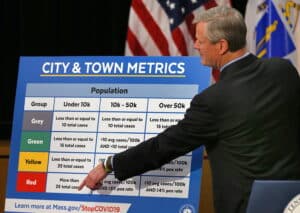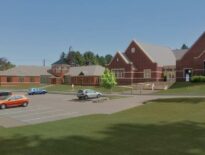
Gov. Charlie Baker gestures to a table of the state's new COVID-19 risk criteria at a Nov. 6, 2020 press conference. Photo by John Tlumacki | Boston Globe Staff / Pool
The Baker administration unveiled a new risk measurement system Friday for cities and towns in Massachusetts, raising the cases required per 100,000 threshold for the “red” designation while adding variables for community size and positive test rate.
The state will now measure color-coded local public health outlooks on different scales for small-, medium- and large-population cities and towns, taking into account both a higher threshold of cases per 100,000 residents as well as positive test rates.
Under the system that has been in place since August, only incidence rates count toward a community’s risk level, with those home to an average daily rate of eight or more cases per 100,000 over the past two weeks marked red.
The change comes over a week into the second surge of COVID-19 infections in Massachusetts. Gov. Charlie Baker told local officials Thursday he feels the state is better prepared to deal with it than it was in the spring.
“The second surge that so many of the folks in the public health community talked about last summer, which now seems like a million years ago, is certainly underway not just here but across the U.S. and frankly across almost all the western democracies,” Baker told local officials gathered for a phone call meeting.
Under the state’s new infection risk map criteria, to earn the highest-risk designation moving forward communities with fewer than 10,000 residents must record more than 25 cases in the sample period. Those with populations between 10,000 and 50,000 must have either 10 or more cases per 100,000 residents or a positive test rate of 5 percent or higher. Those home to more than 50,000 people will only be deemed in the red if they report both at least 10 cases per 100,000 and also a positivity rate of at least 4 percent.
With those changes, the number of communities marked red will be slashed by nearly 85 percent, from 121 in last week’s report under the old metrics to 16 this week under the new metrics.
Asked Friday if the administration was changing the rules to reduce the number of highest-risk communities, Baker said including more measurements improves the utility of the system and helps incentivize testing.
“I happen to think this is a more nuanced and more accurate way to test how communities are doing: not just in terms of their cases per 100,000, but how they’re doing with respect to testing practices and policies,” Baker said. “We want communities to test. I don’t want some communities to say, ‘I’m not going to test because I’m worried about increasing my numbers.'”
The changes bring Massachusetts more in line with how neighboring states measure municipal risk levels and better account for nuance at a granular level, Baker administration officials said Friday.
They pointed as an example to Nahant — a tiny town with a population of slightly more than 3,400 — where only 12 confirmed cases could have pushed it into the red under the older measurement.
Because the count of communities in the red is smaller, the updates will also likely allow more cities and towns to advance into the next stage of economic reopening, in which they can bring back indoor performance venues and several recreational activities.
The new risk group criteria are also closely tied to a fight between teachers’ unions, parents and state education officials over in-person learning. After weeks of prodding schools through press conferences and memos to bring more students back into classrooms, the Baker administration upped the ante Friday by formally urging all communities to avoid remote-only education wherever possible.
New guidance from the state Department of Early and Secondary Education instructs cities and towns in any risk designation below the most severe level to resume fully in-person schooling. Even those in the highest-risk red category should opt for hybrid models rather than fully virtual options, the administration now says.
“[The new metricts] will dramatically reduce the number of communities identified as high-risk just as the numbers of coronavirus cases, hospitalizations and deaths are increasing in Massachusetts,” said Massachusetts Teachers Federation President Merrie Najimy. “There is a real disconnect between the changes and the current situation. In fact, the new metrics may encourage people to relax their guard when they should be more vigilant than ever.”




 |
| 

